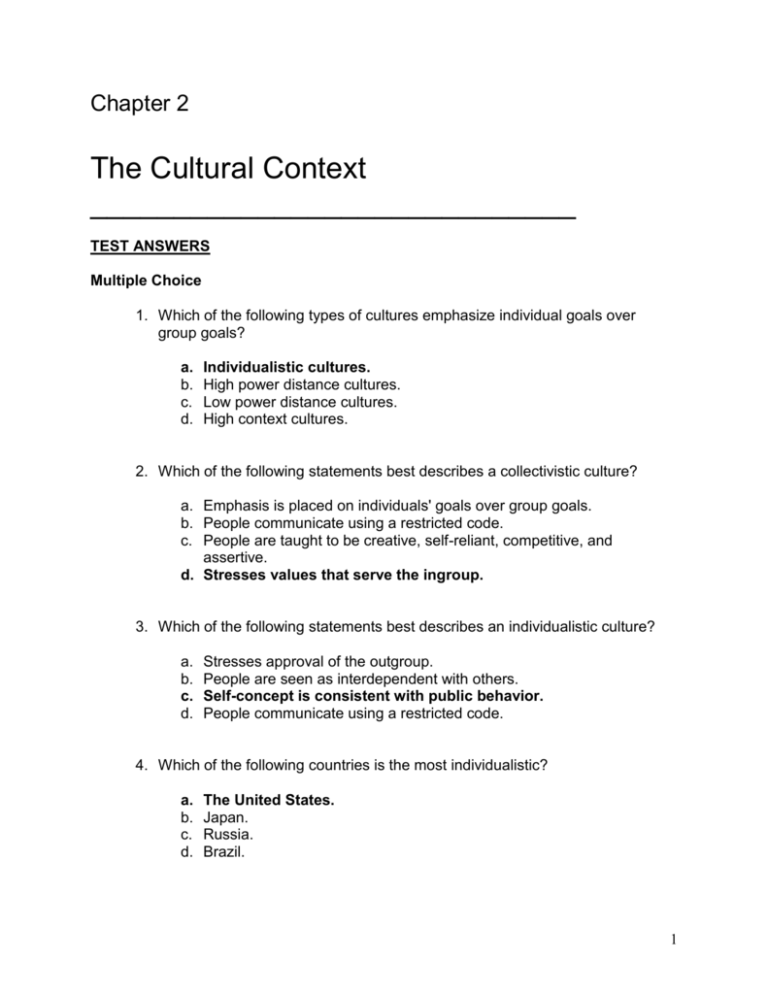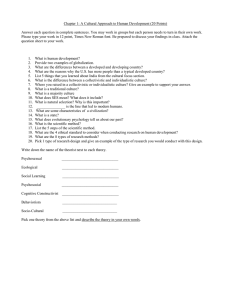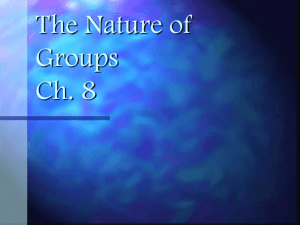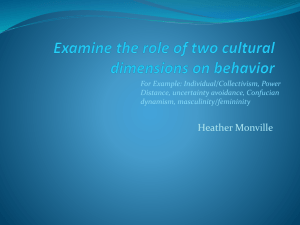Cultural Context Test: Individualism, Collectivism & More
advertisement

Chapter 2 The Cultural Context _____________________________ TEST ANSWERS Multiple Choice 1. Which of the following types of cultures emphasize individual goals over group goals? a. b. c. d. Individualistic cultures. High power distance cultures. Low power distance cultures. High context cultures. 2. Which of the following statements best describes a collectivistic culture? a. Emphasis is placed on individuals' goals over group goals. b. People communicate using a restricted code. c. People are taught to be creative, self-reliant, competitive, and assertive. d. Stresses values that serve the ingroup. 3. Which of the following statements best describes an individualistic culture? a. b. c. d. Stresses approval of the outgroup. People are seen as interdependent with others. Self-concept is consistent with public behavior. People communicate using a restricted code. 4. Which of the following countries is the most individualistic? a. b. c. d. The United States. Japan. Russia. Brazil. 1 5. Which of the following countries is the most collectivistic? a. b. c. d. The United States. Japan. Russia. Brazil. 6. Which of the following statements best describes a high context culture? a. b. c. d. Stresses approval of the outgroup. People are seen as interdependent with others. Self-concept is consistent with public behavior People communicate using a restricted code. 7. Which of the following statements best describes a low context culture? a. b. c. d. People communicate using a restricted code. Nonverbal code is the primary source of information. Verbal code is primary source of information. Heavy reliance on the contextual elements of the communication setting. 8. Which one of the following countries is considered a high context culture? a. b. c. d. Canada. South Korea. England. Saudi Arabia 9. Which one of the following countries is considered a low context culture? a. b. c. d. Germany. Spain. China. Vietnam. 10. Which of the following statements best describes a high power distance culture? a. Inequalities among people are expected and desired. b. Inequalities among people should be minimized. 2 c. People communicate using "powerful" messages (e.g., direct, assertive). d. People communicate using "powerless" messages (e.g., indirect, hesitant). 11. Which of the following statements best describes a low power distance culture? a. Inequalities among people are expected and desired. b. Inequalities among people should be minimized. c. People communicate using "powerful" messages (e.g., direct, assertive). d. People communicate using "powerless" messages (e.g., indirect, hesitant). 12. Which of the following countries is considered high power distance? a. b. c. d. Great Britain. Scotland. Finland. Mexico. 13. Which of the following statements best describes a strong uncertainty avoidant culture? a. b. c. d. Uncertainty is seen as a normal part of life. Uncertainty is seen as a continuous threat. Most of the population experiences communication apprehension. Few people experience communication apprehension. 14. Which of the following statements best describes a weak uncertainty avoidant culture? a. b. c. d. Uncertainty is seen as a normal part of life. Uncertainty is seen as a continuous threat. Most of the population experiences communication apprehension. Few people experience communication apprehension. 15. Persons in small power distance cultures tend to possess: a. greater self-face concern. 3 b. greater other-face concern. c. greater mutual-face concern. d. greater distance face concern. 16. Persons who are certainty oriented: a. b. c. d. undertake activity that maintains clarity. undertake activity that is socially prescribed. undertake activity that is hierarchically prescribed. undertake activity that is monochronically prescribed. 17. Which regions of the United States are considered the most individualistic? a. b. c. d. Deep South and Texas Northeast and Pacific Rim Southeast and Pacific Rim Great Plains and Mountain West 4








